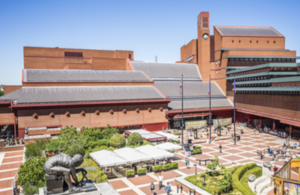British Library building receives highest listed status
Iconic and world-famous library is among 8 UK libraries to receive listed status.

Photo Credit: Tony Antoniou
The British Library has been listed Grade I by Heritage Minister, Tracey Crouch on the advice of Historic England and joins the top 2.5% of listed buildings in England.
Originally designed by architect Sir Colin St John Wilson and his partner MJ Long between 1982 and 1999, it was the largest UK public building to be built in the 20th century. Intended to move and inspire its visitors, today is much-loved and well-used by scholars and members of the public alike for its soaring and stimulating spaces.
With its 5 public floors sweeping upwards like a wave, the architecture is both immense and extraordinary. Surrounded on both sides by 11 Reading Rooms, the Library鈥檚 centrepiece is the magnificent King鈥檚 Library tower, home to the library of George III as well as the Treasures Gallery that hold national Treasures such as Magna Carta, Lindisfarne Gospels and original Beatles lyrics.
The building holds a prominent location on London鈥檚 Euston Road and shaped the emerging character of the surrounding area of north-central London as a place of collaborative research and study - referred to now as the Knowledge Quarter*.
Heritage Minister Tracey Crouch said: 鈥淭he British Library divided opinion from the moment its design was revealed, but I am glad that expert advice now allows me to list it, ensuring that its iconic design is protected for future generations to enjoy.鈥�
The listing coincides with seven libraries from across the UK that have been awarded Grade II status. These are:
- , Suffolk (1963-5, Donald McMorran)
- , The Wirral (1967-71, Paterson, Macauley and Owens)
- , Milton Keynes (1979-81, Buckinghamshire County Council architects)
- , Eastleigh, Hampshire (1981-2, Hampshire County Council architect Colin Stansfield Smith)
- , West Sussex (1965-6, county architect F R Steele)
- , Epsom, Surrey (1967-70, A.G. Sheppard Fidler and Associates)
- , Leamington Spa, Warwickshire (1959-60, Henry Fedeski)
Commenting on all eight listings, Tracey Crouch said: 鈥淟ibraries are the cornerstones of the communities they serve. They act as meeting places, provide areas to learn and are a credit to the volunteers at the heart and soul of the service. Many of these libraries have stood proudly in their communities for more than 50 years and I am thrilled that these institutions can be admired for many years to come.鈥�
Director of Listing at Historic England, Roger Bowdler, said:
鈥淭he British Library is one of England鈥檚 finest modern public buildings. Listing it at Grade I acknowledges its outstanding architectural and historic interest. Colin St John Wilson鈥檚 stately yet accessible design incorporates fine materials and a generous display of public art. The Library鈥檚 dramatic and carefully considered interiors achieve its ultimate goal: of creating a space to inspire thought and learning.
鈥淗istoric England has had a really constructive consultation with the British Library throughout. The way it has been listed celebrates its qualities, and points out just what does make it special. This will enable it to go on flourishing as a dynamic public building, in which appropriate change is welcomed.
鈥淚t joins a select group of other listed post-war public libraries on the National Heritage List for England. Even in today鈥檚 digital age, there is a clear future for these buildings. They illustrate a wide range of architectural styles, and together represent the very best in public architecture.鈥�
Chief Executive of the British Library, Roly Keating, said:
鈥淲e are delighted that Colin St John Wilson鈥檚 courageous and visionary design for the British Library鈥檚 London building has been recognised by a listing at the highest level. Even in the relatively short period since its opening it has worked its way into the affections of millions of visitors and researchers, who have discovered its beautiful spaces, subtle use of natural light and exquisite detailing.
鈥淚t is also a privilege to be listed alongside a group of distinguished public library buildings from across the country. As well as celebrating architectural excellence, this listing is a reminder, in the midst of the digital age, of the vital importance of libraries as physical spaces of the highest quality at the heart of their communities.鈥�
Find out more in our